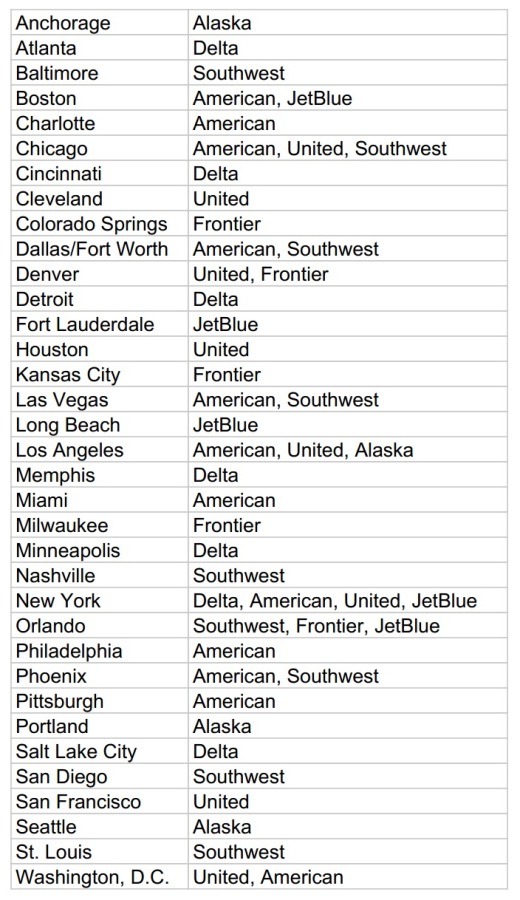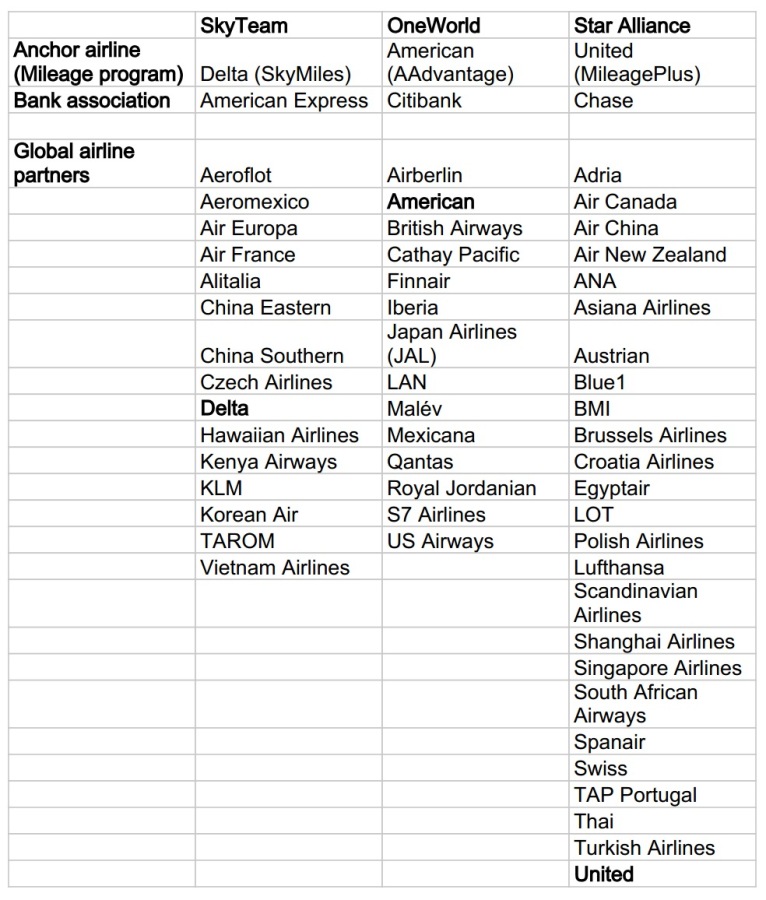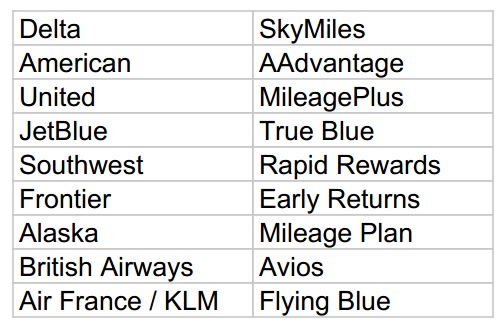Contents
1. Starting Notes
2. Points Vs. Miles (And Their Value)
3. Envisioning a Goal
4. Checking Your Credit
5. Choosing an Airline
6. How to Pick a Card (Or Two)
7. Real Life Examples
8. Score!
9. How to Keep It Going
10. Keeping Track of It All
11. Wonderful Side Effects
12. Final Words
13. Resources
If you just skipped to this section, congratulations! And if you need to get your credit worked out for a while, I empathize. Truly. But either way, you have options. Lots of options, in fact.
![]() Here are a few charts for you to study. They will help you choose an airline or airline alliance that will get you closer to your travel goals.
Here are a few charts for you to study. They will help you choose an airline or airline alliance that will get you closer to your travel goals.
This will be especially helpful if you’re near one of these cities.
Airlines and their major hubs:
Here is another way of viewing the same information:
Airlines and their alliances, banking partners, and airline partners:
Now I got some ‘splainin to do. As you reviewed the charts, you likely saw your city or one near you. Or you recognized a familiar airline. Those are good signs. A few thoughts:
If your city was not listed, find out what airlines service your local airport. There are numerous smaller airlines that have partnerships with the larger ones. Flights on these smaller airlines can also be had for free.
The first two charts include domestic airlines, meaning you can only fly within the U.S. or to a few “near-international” destinations, like the Caribbean islands or destinations in Mexico. Southwest, JetBlue, Frontier, and Alaska Airlines lead the pack for these carriers. Virgin America is another. There are three main airline alliances, too, as you saw in the last chart. The domestic carriers are not included in these alliances for the reason that they only fly within the U.S.
There are three “legacy carriers” featured in three alliances. The three global airline alliances are SkyTeam, Oneworld, and the Star Alliance. Delta is a part of SkyTeam, American is a part of Oneworld, and Star Alliance has United. Each alliance is global, though all three have a slightly different focus. If your goal is to go to South America, I’d recommend Oneworld. For Australia, any of them (United might be best). For Europe and Asia, Star Alliance is wonderful (though all three fly to both). Some remote locations are served by only one airline. Is that airline in one of the three alliances? That would make the decision easy. Keep in mind you can have access to all three at all times, but for starting out, I’ve found it’s helpful to start with just one.
If you live in a city that doesn’t have a legacy carrier, consider flying on a domestic airline to a hub city. For example, someone in El Paso could fly to Houston to catch a flight to Europe on United or one of its partners. Be open to these combinations, as they open up a lot of possibilities.
There are many variables for picking an airline, and by default an airline alliance. It’s a delicate balance, and it may change over time. The trick is to finding that sweet spot of preferred airport, goal destinations, hubs, routes, and ease of use. It’s different for everyone. Perhaps the easiest way to begin is to tell you how I picked Delta and the SkyTeam Alliance.
I live in New York, but I’m originally from northern Mississippi. The closest airport to the Mississippi Delta region is Memphis, Tennessee. A quick search on Kayak.com (a great travel planning tool) tells me there is only one airline with a nonstop flight to Memphis from New York. The carrier is Delta. Makes sense. They operate a hub in Memphis and route a lot of their flights through there. Other options had me connecting in Chicago or Houston (on United), or Dallas or Charlotte (on American). I’m not averse to connecting once in a while, but I prefer direct if possible. Delta also flies out of both La Guardia and JFK here in New York, and is quickly expanding at both airports. Excellent.
That’s one part of the equation. My personal travel goals were Australia and Hawaii. With a little research, I saw Delta has partnerships with both Virgin Australia and Hawaiian Airlines. And as an added bonus, one of their main partners is Air France – great for a free getaway to Paris once in a while. Seeing the list of partners certainly got my mind wandering.
Another thing for me to consider was hub locations. Delta’s main hubs are Atlanta, New York, Memphis, Minneapolis, and Salt Lake City. But Atlanta is absolutely their main hub. New York is a close second. This means that Atlanta’s weather-related delays will affect a lot of their entire network. Once delays start at the hub level, there is a domino effect that ripples out to secondary hubs, then to the smaller airports. This is why you hear reports of people stranded at airports during awful weather. Since Atlanta doesn’t experience as much winter weather as New York, it’s unlikely to get severely delayed in the winter months.
United, however, has Chicago as a main hub and with one in New York as secondary. This means that if there’s a horrible snowstorm in Chicago, the delays could spread very quickly to all other hubs. But Atlanta can get some pretty wicked weather in summer. Betting on Atlanta’s summer weather over Chicago’s in winter is a choice I’ve made from my position in New York. I picked Delta. If I lived in Chicago, though, I would have definitely pick United, weather and all. United also has a strong partnership with Chase Bank, whom I’ve been banking with for years.
Banking partners are another factor. American has Citibank, United has Chase, and Delta has American Express. With my decision to pick Delta, that means that the credit cards I needed to acquire are through American Express.
This combination of location, hubs, and airline and banking partners was a perfect storm for my goals to visit Australia and Hawaii. It also serves me well to get back home quickly and easily (and sometimes freely). I will include other real-life examples that will be helpful in a later section.
Airlines and the names of their mileage programs:
How to choose an airline (checklist):
![]() Consult your travel goals, and find out which airline flies there. Keep in mind if the partners in an airline’s alliance can also get you to your goal destination
Consult your travel goals, and find out which airline flies there. Keep in mind if the partners in an airline’s alliance can also get you to your goal destination
![]() If you have more than one option, consider hub locations and banking partners
If you have more than one option, consider hub locations and banking partners
![]() Those in rural places might consider taking a domestic airline like Southwest, Frontier, Alaska, or JetBlue to a larger city as this will open up global options
Those in rural places might consider taking a domestic airline like Southwest, Frontier, Alaska, or JetBlue to a larger city as this will open up global options
Next up: How to Pick a Card (Or Two)
Earn easy shopping rewards with Capital One Shopping—just log in and click a link.
Announcing Points Hub—Points, miles, and travel rewards community. Join for just $9/month or $99/year.
BEST Current Credit Card Deals
The responses below are not provided or commissioned by the bank advertiser. Responses have not been reviewed, approved or otherwise endorsed by the bank advertiser. It is not the bank advertiser's responsibility to ensure all posts and/or questions are answered.






Leave a Reply